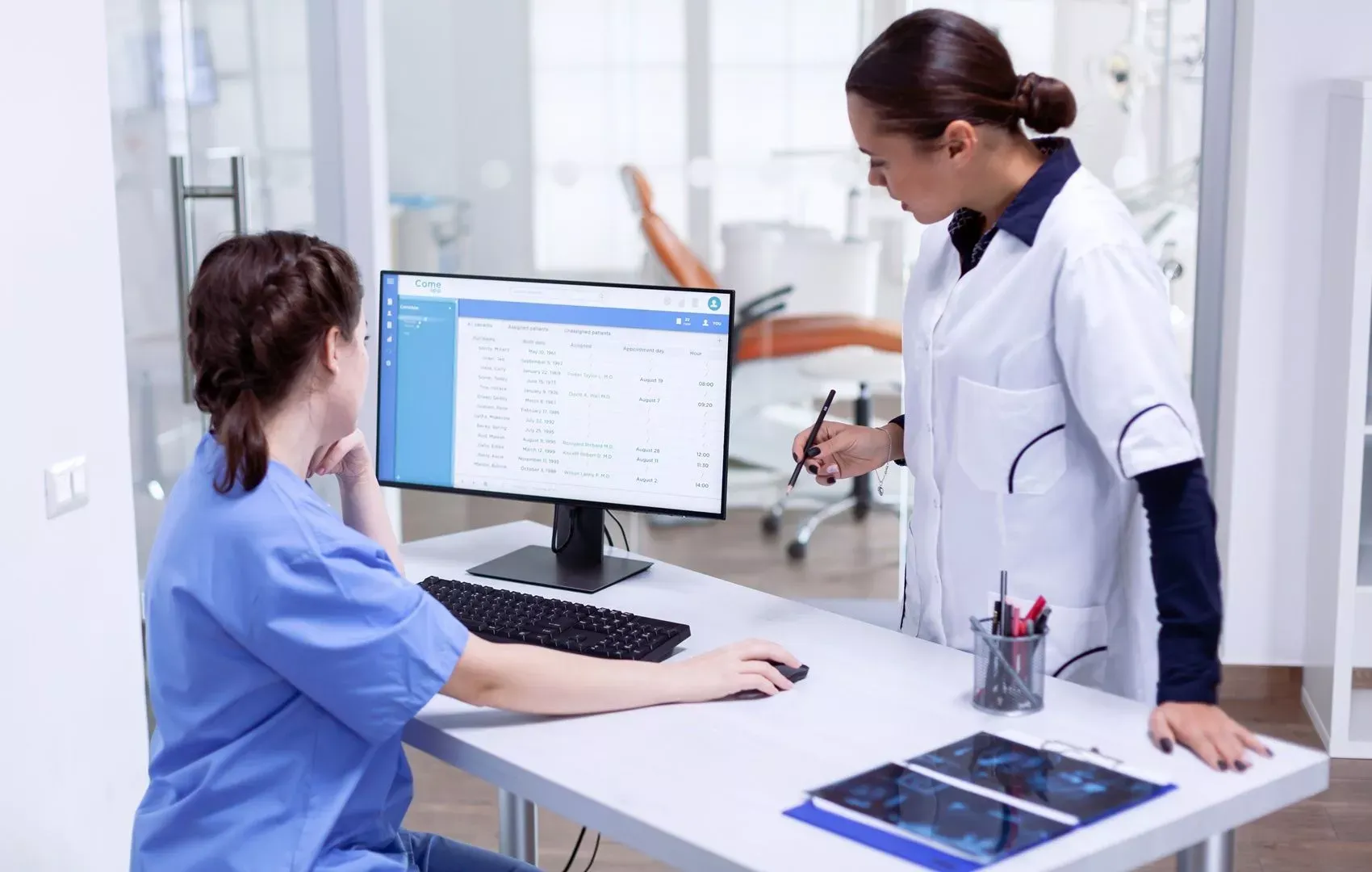Opening an office is an important decision in the career of any health professional, after all, not everyone chooses this path, often having a long trajectory exercising the profession in clinics, for example.
Opening an office requires planning that goes far beyond purchasing equipment and regulating the location. Other elements are essential for the smooth running of any business, and in the health area, it could not be different. These elements consist of client addition, customer service, loyalty, and management.
To help you on your journey, we have separated in this article the 4 essential steps you must follow to have a successful practice. Remember that these steps are not the kickoff for opening your business, but rather methods to keep you always steadfast in the labor market, especially during competition, but healthily and honestly.
Before we continue, we need to know: do you already use medical software to perform your appointments? We invite you to discover Ninsaúde Apolo, an online software that can be used on a tablet, smartphone, or in the traditional way on computers. Learn more at our apolo.app website.
Customer acquisition
Attracting customers - in this case, patients - is essential for you, as a health professional, to establish yourself in the market. Your office can be the coziest and modern in the city and your service can be the most humanized, but none of these advantages will matter if people don't know you and don't know where to find you.
But before taking any action, you must analyze your past and future patients, thus identifying your target audience through some basic information:
- Where are your patients located?
- What is their age group?
- What type of procedure is most sought after?
- Did they find you for the price (low cost) or the "fame" (high quality)?

Knowing the answer to these questions, you can better target your marketing campaigns, which can be done in different ways, including online. Billboards scattered in strategic points of the city can be a good tool, but nowadays, having a presence on the internet is one of the best options. Some of the ways to capture customers via the internet are:
Google My Place
This is a free tool that enables companies to manage their business information, that is, what people see when they search the web, including Google Maps and Google Search. Besides the various features that add value to your office's digital presence, if it is registered with Google My Business, it will be displayed prominently on the right side of the Google page with all the information that you have filled in. That's why this registration must be updated, including the address, opening hours, and a valid contact phone number.
Social networks
Having a profile on social media is extremely important, as, in addition to potential customers being able to find you more easily, it's also a straightforward way to maintain communication through posts that can also be informative for your followers.
The most used social networks nowadays are Facebook and Instagram, and each one has its peculiarities. On Facebook you can choose to have a profile or a page, the latter being the most suitable option for professional purposes. On the page, you can enter office hours, and contact phone, if you use management software such as Ninsaúde Apolo, you can insert the online scheduling link. On Instagram you also have this possibility, however, posts on this social network are more restricted to photos and short videos.
You can also try TikTok, where with a little creativity you can create short informative videos, but always remember to obey the HIPAA rules regarding marketing on all types of platforms.
Office website
Even keeping social networks active, it is interesting that your office has its website because through it it will be possible to attract that portion of patients who are outside Facebook and Instagram, for example.
By creating a website, you can also better build the office's visual identity and can add other information that on social networks are not always visible quickly and clearly to the patient, such as the services offered, agreements, and partners, in addition, of course, to the online scheduling already mentioned before.
Blog
Blogs are sites where you can write long texts on various subjects that involve your specialty, therefore whenever a patient searches for a certain subject on the internet, he could fall like a parachute on your blog and consequently learn about your work. But it is important to emphasize that the blog cannot be used for any type of patient consultation, being restricted to information only.
The blog can also be integrated into the clinic's website, and whenever you write a new post, you can share the link on your social networks. Furthermore, through this platform, you can filter visitor comments so that they are posted only after verification by a moderator. There are some free platforms for blogging, such as WordPress, Blogger, and Medium, but to give more credibility to the information the blog must have its own domain. Generally the most used are those that end in .com.
Remember that everything on the internet can be promoted by paid actions within the web itself, that is, you can create marketing campaigns so that your posts on social media appear to people who don't follow you, thus attracting new followers and potential customers, or in the case of your website, you can create campaigns so that it appears on the first page of Google.
Attendance
How you care for your patients directly impacts your reputation as a healthcare professional, and consequently the success of your practice. But unlike what many people imagine, this reputation does not just depend on the health professional, but on everything and everyone involved in the service.
The first tip is to pay attention to the office reception. Hire someone who, can not only carry out day-to-day tasks effectively, but also be able to keep the reception organized, but above all, you will be committed to providing good care to patients. In this sense, it is also important to offer several scheduling options and communication channels, that is, do not limit yourself to conventional telephone service: online scheduling and WhatsApp tools make life easier not only for the secretary but also for the patient.
One of the biggest complaints from patients is related to the delay in starting care, that is, you make an appointment for 2:00 pm but start the service around 3:00 pm. We know that unforeseen events can happen and it is not always possible to avoid this type of situation, but planning to keep the medical schedule organized is paramount.
To do this, avoid placing too many patients at very close times, and use a management system to keep the schedule well structured. Using a system can also help your secretary who will have more free time to receive patients better, and you will also carry out your appointments faster, but without losing your professionalism.

Regarding the medical consultation itself, something essential is to maintain humanized care. In reality, this type of service starts at the reception, where the patient needs to feel comfortable so that he/she realizes that they are in a safe environment. Whether at the reception or in the healthcare professional's room, it is also necessary to use an individualized approach, that is, treat the patient as a unique human being, not just another one on the waiting list.
Transmitting trust and empathy are the keys to the success of good service, especially with those patients who are extremely fragile. In this context, it is also important to avoid using technical terms and prefer transparent information, and be proactive about the overall picture and the results obtained.
Patient loyalty
A good loyalty plan is to capture, convince and retain. But after all, how to do this correctly within the health area? Well, the first step towards loyalty happens during the service itself, so following the steps mentioned above, much of the loyalty work will already be done, in other words:
- Create a pleasant environment in your office;
- Use management software to organize the schedule;
- Offer personalized and humanized service;
- Send appointment reminders;
- Do not delay appointments, avoiding leaving the patient waiting for a long time at the reception;
- Convey information.
But to retain a patient, it is necessary to think not only about the moment he is in the office but also about after-care. Many professionals think that after the patient leaves their room, there is no need to maintain a connection, but that is completely wrong thinking. This connection can be from a happy birthday, Christmas, and new year message, or even in more obvious acts, such as a reminder to return.
Facilitating the payment of consultations is also a good technique to retain your patients. When we talk about facilitating payments, it doesn't necessarily mean giving a discount (which in a way is also something that can be done) but facilitating the payment methods.
Beyond the traditional cash, you can also offer debit and credit cards, but first, it is important to be aware of the fees you will pay. For the health professional, installment payment is only a good option in cases of procedures with higher costs, and in this case, it can make the patient's life much easier.
Management
The good management of an office is the result of a set of actions, including those mentioned above: good techniques to attract customers, excellence in patient care, and loyalty. But something essential for the good execution of all these actions is the organization. For that, without a doubt, the most recommended is to use management software. With software to manage your office it is much easier:
- Register new patients and update old records;
- Keep the medical schedule always full in an organized way;
- Confirm appointments and send reminders to patients automatically;
- Generate TISS guides and send them to agreements in an automated way;
- Maintain the confidentiality of medical records following the HIPAA rules;
- Serve patients faster and more dynamically, keeping their data safe;
- Organize the office's finances;
- Carry out marketing and after-service actions, among others.
With software like Ninsaúde Apolo, for example, it is possible to perform all of the above actions, in addition to many others. Management software, when well structured, can help at all stages, not only in patient care but also in the financial health of the office itself. With software, both the health professional and the secretary have access to reports and graphics where you can compare the best-selling services and the most profitable ones, as well as being able to print amounts of receipts and payments made in the office, cash flow, commissions, billing, stock, among others.

Although using a management system can be of great help, it is important to remember that it needs someone to feed its information. In this sense, it is important to know that some actions done wrongly can impact not only the professional's agenda but also the financial part. A very common mistake is to record only receipts and forget about payments. Another very common case concerns professionals who mix their office finances with their personal finances. For more details on the subject, check out some tips we wrote in our article "The importance of cash flow in the clinic and how to do it".
So, did you like the tips? Keep following the blog to stay on top of more content like this. Are you a healthcare professional but do not yet use management software for your clinic or practice? Meet Ninsaúde Apolo.
